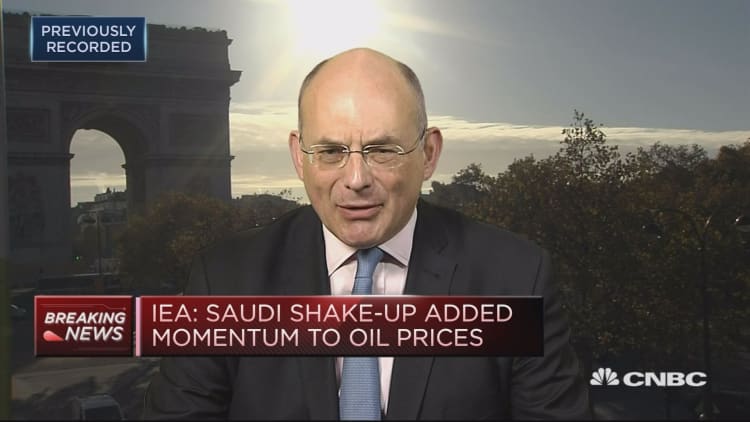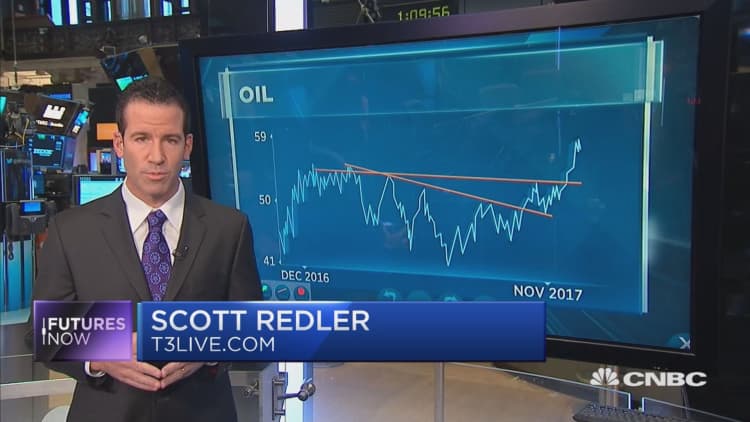Oil consumption and demand is expected to remain robust into the 2040s despite a diversifying global energy mix and the rise of electric car sales, according to the International Energy Agency (IEA).
In its annual World Energy Outlook 2017 report, published Tuesday, the IEA said that over the next two decades the global energy landscape would be reshaped by four major forces.
"The United States is set to become the undisputed global oil and gas leader; renewables are being deployed rapidly thanks to falling costs; the share of electricity in the energy mix is growing; and China's new economic strategy takes it on a cleaner growth mode, with implications for global energy markets."
Still, despite an expected rise in solar and wind as major sources of energy as a result of changes in direction within national energy policies such as China, India and Europe, the IEA cautioned that it was "too early to write the obituary for oil."
"Even as rising oil demand slows down, it is not reversed before 2040 even as electric-car sales rise steeply," it said.

"Global oil demand continues to grow to 2040, although at a steadily decreasing pace — while fuel efficiency and rising electrification bring a peak in oil used for passenger vehicles, even with a doubling of the car fleet to 2 billion vehicles," it said.
It added that other sectors — namely petrochemicals, trucks, aviation, and shipping — will keep driving up oil demand to 105 million barrels a day by 2040.
The 'low oil price case'
The IEA's annual outlook does not offer a forecast of what the energy system will look like but instead presents various projections to 2040 based on different policy assumptions, "in order to give policymakers the tools to decide what path to follow," the IEA noted.
This year's report looked a number of potential long-term pathways for oil with each scenario based on different assumptions about future policies and technologies.
One scenario within the report was the "low oil price case," which looked at what it might take to keep oil prices in a $50 to $70 a barrel range (currently a barrel of oil is around the $60 mark) all the way through to 2040.
It said the main conditions of keeping prices within the range were:
- A high resource assumption for U.S. shale oil;
- Widespread uptake of digital and other technologies that help keep a lid on costs in the upstream part of the industry (the part that finds and produces crude oil)
- Exceptionally rapid growth in the electric car fleet;
- And a favorable assumption about the ability of the main resource owners to weather the storm of lower revenues
One of the key findings of this "low oil price case" was that even a rapid growth in the world's electric car fleet was "unlikely to have a substantial impact on oil consumption for passenger transport until the mid-2020s," the IEA said.
"Indeed, in the absence of a major switch in policy direction, there is likely to be continued robust growth in other sectors, including trucks, aviation, maritime transport and petrochemicals. This is a continuation of the strong demand growth we are seeing in our short term oil market analysis."
$60 a barrel oil
The report comes at a time when oil markets are being closely watched for signs of recovery and a rebalancing following a slump in 2014 caused by a glut in global supply and trailing demand.
Oil prices have been buoyed in recent months by the decision by major oil producing group OPEC, and non-OPEC producers including Russia, to limit their oil output. However, rising U.S. oil output is putting a lid on price rises.

Benchmark Brent crude is currently trading at $62.87a barrel and U.S. West Texas Intermediate at $56.57, and, although a far cry from the lows seen in early 2015 when oil prices tumbled to the mid-$20s, experts say markets shouldn't expect prices above $60 a barrel to last.
On Monday, Fitch Ratings said in its 2018 oil outlook that it assumed 2018 average oil prices would be broadly unchanged year-on-year and that the recent price recovery with Brent exceeding $60 per barrel may not be sustained, Reuters reported.
The IEA agreed, noting on Tuesday in its monthly oil market report, that markets should not expect $60 a barrel to become "the new normal" with more supply expected from non-OPEC producers.
"The reality is that even after some modest reductions to growth, non-OPEC production will follow this year's 700,000 barrels a day growth with 1.4 mb/d of additional production in 2018 and next year's demand growth will struggle to match this. This is why, absent any geopolitical premium, we may not have seen a 'new normal' for oil prices," the IEA said.
It added that higher oil prices and relatively mild early winter temperatures had contributed to a downward revision of its demand forecast in November, revised downwards by 100,000 barrels a day for both 2017 and 2018. It now sees demand growth of approximately 1.5 million barrels a day (mb/d) in 2017, to 97.7 mb/d, and 1.3 million barrels a day in 2018 to 98.9 mb/d.
The IEA noted that the market would continue on its journey towards a rebalancing, saying that "for the overall market balance, our changes to demand growth, which remains robust, and supply largely cancel each other out." However, non-OPEC production was expected to add to the global supply of oil.
"Using a scenario whereby current levels of OPEC production are maintained, the oil market faces a difficult challenge in the first quarter of 2018 with supply expected to exceed demand by 600,000 barrels a day followed by another, smaller, surplus of 200,000 barrels a day in the second quarter of 2018," the IEA said.



